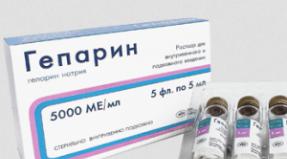Flemoxin Solutab: instructions for use for adults and children. "Flemoxin Solutab" - instructions for use for children In what cases the drug is prescribed
"Flemoxin Solutab" is one of the drugs in the category of antibiotics, which is widely used in children's practice. The product dissolves perfectly in any liquid - juices, drinking water, milk - it has a pleasant sweetish taste.
The composition of the means "Flemoxin Solutab"
The main component is amoxicillin.
Excipients are:
- dispersible cellulose;
- crospovidone;
- vanillin;
- flavors (taste identical to tangerine and lemon);
- magnesium stearate;
- saccharin.
Indications for the appointment of "Flemoxin Solutab" in childhood

"Flemoxin Solutab" is used in the treatment of diseases respiratory tract, as well as pathologies of the ENT organs.
Additionally, the drug can be prescribed during therapy. bacterial infections affecting:
- skin surface and subcutaneous tissue layer;
- the child's urinary system;
How to take Flemoxin Solutab
The instruction for children contains the following instructions. The child can take a tablet of the drug:
- swallow whole with any liquid;
- chew (the drug has a sweetish fruity taste) and drink plenty of liquid.
If necessary, the tablet can be dissolved in water:
- If you need to get a syrup, then 20 ml of liquid is taken for one tablet.
- The suspension is obtained if the tablet is diluted with 100 ml of water.
Scheme of taking the means "Flemoxin Solutab" ( the dosage depends on the number of full years of the child):
- children over ten years old: 500.0 ... 750.0 mg twice a day with an interval of 12 hours, or 375.0 ... 500.0 mg three times a day (every 8 hours);
- from three to ten years: 375.0 mg every 12 hours or 250.0 mg every 8 hours;
- from one to three years: 250.0 mg twice a day or 125.0 mg three times a day.
The dosage depends on the following indicators:
- age;
- baby's weight;
- the severity of the course of the disease.
The daily dose is calculated on the basis that 30.0 ... 60.0 mg of the drug "falls" per kilogram of the child's weight. The daily rate should be divided into several receptions, most often, no more than three.
The duration of the course of taking "Flemoxin Solutab" depends on the severity of the course of the disease:
- with mild and moderate severity - 5 ... 7 days;
- in severe / protracted form - at least 10 days.
Features of taking the drug

If the child has kidney problems, the doctor will lower the daily intake of the drug. It depends on the severity of the existing pathology and the dosage can ultimately be reduced by half (at the discretion of the specialist).
You can drink Flemoxin Solutab at any time, regardless of food intake.
Dr. Komarovsky considers Flemoxin Solutab the safest antibiotic for children. The medication is practically non-toxic, and therefore, if necessary, can be used in children of the first year of life.
And to the question: "Is it possible to give the drug to newborns?", Komarovsky gives a positive answer.
Side effects accompanying taking the drug
Since Flemoxin Solutab belongs to the group of penicillin antibiotics, the following side effects may occur after taking the drug:
- the appearance of skin rashes like urticaria;
- development of angioedema.
Side effects from the side may also develop:
- Gastrointestinal tract. It can be an attack of nausea, accompanied by vomiting, upset stools, appetite disorders. Sometimes - an increase in the permissible amount of liver enzymes and the occurrence of hemorrhagic colitis.
- Genitourinary system. Very rarely, interstitial nephritis develops during the period of taking the drug.
- Hematopoietic organs. When a blood test is performed, a decrease in the number of platelets and neutrophils can be determined. In rare cases, hemolytic anemia is diagnosed.
Contraindications to the use of the drug in childhood

The drug is prohibited from taking if the child has:
- individual intolerance to the component composition of the medication;
- drug allergy to drugs that are part of the penicillin and cephalosporin series.
With the available renal failure, as well as lymphocytic leukemia and mononucleosis, the drug is prescribed with extreme caution.
Release form
The drug is offered in the form of dispersible - easily dissolving in water - tablets of various dosages.
Analogues of the means "Flemoxin Solutab"
The main active ingredient of the antibiotic is amoxicillin trihydrate. Analogues of the remedy are many drugs, which are also based on amoxicillin trihydrate. It:
- "Amoxicillin";
- "Amoxicar";
- Ospamox, etc.
The difference between Flemoxin Solutab and its counterparts:
- release form;
- dispersible - rapidly dissolving in water - structure of the preparation.
Overdose and measures to eliminate it

Signs of an overdose will be:
- bouts of nausea, ending with vomiting;
- bowel disorder;
- violations of water and electrolyte balance.
Symptomatic therapy:
- gastric lavage is performed;
- the intake of enterosorbents is required;
- appointment is scheduled aqueous solutions electrolytes.
Storage of the drug and shelf life
Store the medicine at a temperature not exceeding +25. Expiration date - within five years from the date of issue.
Published on this page detailed instructions by application Flemoxina Solutaba... The available dosage forms of the drug are listed (tablets 125 mg, 250 mg, 500 mg and 1000 mg), as well as its analogues. Information is provided on the side effects that the antibiotic Flemoxin Solutab can cause, on the interaction with other drugs. In addition to information about the diseases for the treatment and prevention of which a drug is prescribed (tonsillitis, sinusitis, cystitis and other infectious diseases), admission algorithms are described in detail, possible dosages for adults, children, the possibility of use during pregnancy and lactation is being specified. Annotation to Flemoxin Solutab supplemented with reviews of patients and doctors.
Instructions for use and dosage
The drug is taken orally. The drug is prescribed before, during or after a meal. The tablet can be swallowed whole, divided into parts or chewed with a glass of water, and can also be diluted in water to form a syrup (20 ml) or suspension (100 ml) with a pleasant fruity taste.
The dosage regimen is set individually, taking into account the severity of the course of the disease, the sensitivity of the pathogen to the drug, the age of the patient.
In the case of infectious and inflammatory diseases of mild and moderate it is recommended to use the drug according to the following scheme: adults and children over 10 years of age are prescribed 500-750 mg 2 times a day or 375-500 mg 3 times a day; children aged 3 to 10 years are prescribed 375 mg 2 times a day or 250 mg 3 times a day; children aged 1 to 3 years are prescribed 250 mg 2 times a day or 125 mg 3 times a day.
The daily dose of the drug for children (including children under 1 year of age) is 30-60 mg / kg per day, divided into 2-3 doses.
When treating severe infections, as well as in hard-to-reach foci of infection (for example, acute otitis media), a three-time dose is recommended.
For chronic diseases, recurrent infections, infections severe course adults are prescribed 0.75-1 g 3 times a day; children - 60 mg / kg per day, divided into 3 doses.
In acute uncomplicated gonorrhea, 3 g of the drug is prescribed in 1 dose in combination with 1 g of probenecid.
In case of infections of mild to moderate severity, the drug is taken within 5-7 days. However, for infections caused by Streptococcus pyogenes, the duration of treatment should be at least 10 days.
The drug must be continued for 48 hours after the symptoms of the disease disappear.
Forms of issue
Dispersible tablets 125 mg, 250 mg, 500 mg and 1000 mg. Can be diluted in water to prepare a suspension or syrup for oral administration.
Flemoxin Solutab- antibiotic of the group of semisynthetic penicillins wide range actions. It is a 4-hydroxyl analogue of ampicillin. Has a bactericidal effect. Active against aerobic gram-positive and gram-negative bacteria.
Microorganisms that produce penicillinase are resistant to amoxicillin (the active ingredient of Flemoxin Solutab).
In combination with metronidazole, it is active against Helicobacter pylori... It is believed that amoxicillin inhibits the development of resistance of Helicobacter pylori to metronidazole.
Cross-resistance exists between amoxicillin and ampicillin.
The spectrum of antibacterial action expands with the simultaneous use of amoxicillin and a beta-lactamase inhibitor clavulanic acid. This combination increases the activity of Flemoxin Solutab against Bacteroides spp., Legionella spp., Nocardia spp., Pseudomonas (Burkholderia) pseudomallei. However, Pseudomonas aeruginosa, Serratia marcescens, and many other gram-negative bacteria remain resistant.
Pharmacokinetics
When taken orally, Flemoxin Solutab is quickly and completely absorbed from the gastrointestinal tract, not destroyed in the acidic environment of the stomach. When the dose is doubled, the concentration also doubles. In the presence of food in the stomach, it does not decrease total absorption. It is widely distributed in tissues and body fluids. Reported on high concentrations amoxicillin in the liver (therefore, the simultaneous intake of ethanol (alcohol) negatively affects this organ with the possibility of developing liver failure).
About 60% of the dose taken orally is excreted unchanged in the urine by glomerular filtration and tubular secretion. A certain amount of amoxicillin is determined in the feces.
In small amounts, amoxicillin penetrates the BBB during inflammation of the pia mater.
Indications
- infectious and inflammatory diseases (of the respiratory system, genitourinary system, skin) caused by sensitive microorganisms, incl. bronchitis, pneumonia, tonsillitis, pyelonephritis, urethritis, gastrointestinal tract infections, gynecological infections, infectious diseases of the skin and soft tissues, listeriosis, leptospirosis, gonorrhea;
- For use in combination with metronidazole: chronic gastritis in the acute phase, gastric ulcer and duodenum in the acute phase associated with Helicobacter pylori.
Contraindications
- hypersensitivity to the components of the drug;
- hypersensitivity to other beta-lactam antibiotics, incl. to other penicillins, cephalosporins, carbapenems.
special instructions
The drug should be prescribed to patients with infectious mononucleosis and lymphocytic leukemia with caution, since there is a high likelihood of exanthema of non-allergic genesis.
A history of erythroderma is not a contraindication for the administration of Flemoxin Solutab.
Possible cross-resistance with drugs of the penicillin series and cephalosporins.
The appearance of severe diarrhea, characteristic of pseudomembranous colitis, is an indication for discontinuation of the drug.
During the course of treatment, it is necessary to monitor the state of the function of the hematopoietic organs, liver and kidneys.
The development of superinfection due to the growth of microflora insensitive to the drug is possible, which requires a corresponding change in antibiotic therapy.
With the simultaneous use of estrogen-containing oral contraceptives and amoxicillin, you should, if possible, use other or additional methods contraception.
Influence on the ability to drive vehicles and use mechanisms
No adverse drug effects reported on control ability vehicles or work with mechanisms.
Side effect
- change in taste;
- nausea, vomiting;
- diarrhea;
- dysbiosis;
- stomatitis, glossitis;
- hepatic cholestasis;
- pseudomembranous and hemorrhagic colitis;
- leukopenia, neutropenia, thrombocytopenic purpura, eosinophilia, thrombocytopenia, agranulocytosis, hemolytic anemia;
- agitation, anxiety;
- insomnia;
- ataxia;
- confusion of consciousness;
- change in behavior;
- depression;
- peripheral neuropathy;
- headache;
- dizziness;
- skin reactions, mainly in the form of a specific maculopapular rash;
- hives;
- hyperemia of the skin;
- erythematous rash;
- rhinitis;
- conjunctivitis;
- arthralgia;
- toxic epidermal necrolysis;
- allergic vasculitis;
- anaphylactic shock;
- angioedema;
- labored breathing;
- vaginal candidiasis;
- superinfection (especially in patients with chronic diseases or reduced body resistance).
Drug interactions
Probenecid, phenylbutazone, oxyphenbutazone, diuretics, allopurinol, NSAIDs, to a lesser extent acetylsalicylic acid and sulfinpyrazone suppress the tubular secretion of penicillins, which leads to an increase in T1 / 2 and an increase in the concentration of amoxicillin in the blood plasma.
Bactericidal antibiotics (including aminoglycosides, cephalosporins, vancomycin, rifampicin) show synergy when taken simultaneously.
Antagonism is possible when taken with some bacteriostatic drugs (for example, chloramphenicol, sulfonamides).
Simultaneous reception of Flemoxin Solutab with estrogen-containing per oral contraceptives can reduce the effectiveness of the latter and increase the risk of acyclic bleeding.
Antacids, glucosamine, laxatives medicines, aminoglycosides, food reduce absorption. Ascorbic acid enhances absorption.
Increases efficiency indirect anticoagulants(suppressing the intestinal microflora, reduces the synthesis of vitamin K and the prothrombin index); enhances the absorption of digoxin.
The simultaneous use of amoxicillin with allopurinol increases the risk of developing skin rashes.
Analogs of the drug Flemoxin Solutab
Structural analogues for the active substance:
- Amoxisar;
- Amoxicillin;
- Amosin;
- Gonoform;
- Grunamox;
- Danemox;
- Ospamox;
- Hikontsil;
- Ecobol.
Application during pregnancy and lactation
The use of the drug Flemoxin Solutab during pregnancy and lactation is possible if the expected benefit of therapy for the mother outweighs the risk of developing side effects in the fetus and infant.
In small amounts, amoxicillin is excreted with breast milk, which can lead to the development of sensitization phenomena in an infant.
Flemoxin solutab - medicinal product, a broad-spectrum antibiotic.
The active component of the drug is amoxicillin, which has an antibacterial effect. It is used for various inflammatory and infectious processes of the upper and lower respiratory tract, gastrointestinal tract, genitourinary system, soft tissues.
The duration of antibiotic therapy for mild and moderate infections is about 5-7 days, and in cases of infections provoked by Streptococcus pyogenes - 10 days. Disappearing clinical manifestations the disease is by no means a signal for immediate discontinuation of the drug: it should be taken for another 2 days. If the use of flemoxin is accompanied by severe diarrhea, then the presence of pseudomembranous colitis can be assumed. In such cases, the drug must be canceled.
Clinical and pharmacological group
Antibiotic of the group of semi-synthetic penicillins with a broad spectrum of action.
Conditions of sale from pharmacies
Can buy with a doctor's prescription.
Price
In Moscow pharmacies, the average cost of Flemoxin Solutab is:
- Flemoxin Solutab tablets 125 mg - 230-270 rubles.
- Flemoxin Solutab tablets 250 mg - 300-330 rubles.
- Flemoxin Solutab tablets 500 mg - 370-410 rubles.
- Flemoxin Solutab tablets 1000 mg - 520-550 rubles.
Composition and form of release
Dispersible tablets Flemoxin Solutab:
- 125, 250, 500 or 1000 mg pack No. 20 (blisters of 5 pcs., 4 blisters per pack);
- 125 mg pack No. 14 (blisters of 7 pcs., 2 blisters per pack).
Dispersible (water-soluble) tablets include amoxicillin in the form of amoxicillin trihydrate (Amoxicillin trihydrate), microcrystalline and dispersible cellulose, vanillin, crospovidone, flavorings (lemon and tangerine), magnesium stearate, saccharin.
Tablets are oval, white or white with a yellowish tinge, with a dividing line on one side, and a digital designation (231, 232, 234 and 236) and the manufacturer's logo on the other.
Pharmacological effect
Amoxicillin is a semi-synthetic β-lactam antibiotic penicillin group with a wide spectrum of antimicrobial activity.
The bactericidal properties of the drug are due to the ability to suppress transpeptidase, disrupt the production of peptidoglycan (a supporting protein of cell walls) during periods of division and growth, and provoke lysis of microorganisms.
Shows activity against Gram (+) aerobes, including Staphylococcus spp. (with the exception of strains producing penicillinase) and Streptococcus spp. (including Str.pneumoniae and faecalis); Gram (-) aerobes (gonococci, meningococci, Escherichia coli and Haemophilus influenzae, Proteus mirabilis; certain strains of Klebsiella, Shigella and Salmonella, as well as against H. pylori.
Ineffective against P. rettgeri and vulgaris proteus strains (they are indole-positive), serration, pseudomonas, enterobacteria, morganella morgani. Mycoplasma, rickettsia and viruses are resistant to the action of amoxicillin.
Feature dosage form is that the tablets are readily dispersed in water to form a dispersion. Due to this, the drug is quickly and completely absorbed (more than 93% of the dose taken) from the alimentary canal. Food intake does not affect the absorption of the substance. TCmax - in the range from 60 to 120 minutes. When taking dispersible tablets, the plasma concentration of amoxicillin is higher than when taking insoluble forms of the drug. The active substance is acid-resistant.
Indications for use
Flemoxin Solutab tablets are intended for the treatment of diseases caused by microorganisms sensitive to Amoxicillin:
- infections of the musculoskeletal system, including osteomyelitis;
- infectious diseases of the skin and soft tissues - pyoderma, streptoderma, boils, carbuncles,;
- infectious diseases urinary tract and kidney -, interstitial nephritis;
- inflammatory diseases of the female genital organs - salpingitis, endocervicitis, septic complications after abortion or childbirth, endometritis;
- diseases of the respiratory system of an inflammatory and infectious nature - complicated, hospital pneumonia.
Contraindications
The use of Flemoxin Solutab is contraindicated in patients with syndrome intolerance to the components of the drug and other beta-lactam antibiotics, including other carbapenems, cephalosporins and penicillins.
Diseases / conditions for which the drug is prescribed with caution:
- Infectious mononucleosis;
- lymphocytic leukemia;
- a history of diseases of the gastrointestinal tract (especially colitis associated with the use of antibacterial agents);
- renal failure;
- allergic reactions, including polyvalent hypersensitivity to xenobiotics (including a history);
- pregnancy;
- period of breastfeeding.
Appointment during pregnancy and lactation
The use of Flemoxin Solutab during pregnancy and lactation is possible if the expected benefit of therapy for the mother outweighs the risk of side effects in the fetus and infant.
In small quantities, amoxicillin is excreted in breast milk, which can lead to the development of sensitization phenomena in an infant.
Dosage and method of administration
As indicated in the instructions for use Flemoxin Solutab should be taken orally before, simultaneously or after a meal.
Flemoxin Solutab can be swallowed whole, chewed or divided into parts and washed down with a glass of water, or diluted in 20 or 100 ml water until a syrup or suspension with a pleasant fruity taste is formed.
The regimen for taking the drug is established by the doctor on an individual basis. When determining it, he takes into account the severity of the condition, the age of the patient and the sensitivity of the infectious agent to the action of amoxicillin.
- children 1-3 years old: 2 times a day, 250 mg, or 3 times a day, 125 mg;
- children 3-10 years old: 2 times a day, 375 mg, or 3 times a day, 250 mg;
- children from 10 years old and adults: 2 times a day, 500-750 mg, or 3 times a day, 375-500 mg.
The dose of Flemoxin Solut for children (including under the age of 1 year) depends on weight and is 30-60 mg / kg per day, divided into 2-3 doses.
In cases of severe infections, as well as in the treatment of hard-to-reach foci of infection (for example, otitis media in acute course) daily dose Flemoxin Solutaba is recommended to be divided into 3 doses.
In high doses, the drug is used for recurrent infections, chronic diseases and infections in severe course: children - 60 mg / kg per day, divided into 3 doses, adults - 3 times a day, 750-1000 mg.
In acute uncomplicated gonorrhea, combined therapy is performed: Flemoxin Solutab - 3000 mg and probenecid - 1000 mg (once).
With functional impairment of the kidneys (in patients with creatinine clearance ≤ 10 ml per minute), a dose reduction of 15-50% is shown.
Course duration:
- moderate / mild infections: 5–7 days; longer use (at least 10 days) is indicated in cases of treatment of infections that are caused by Streptococcus pyogenes;
- severe infections, chronic diseases: duration is determined clinical picture; after the disappearance of the symptoms of the disease, therapy is continued for another 48 hours.
Adverse Reactions
Side effects are manifested in the form:
- nausea, changes in taste, diarrhea, vomiting, a moderate increase in the activity of liver enzymes (sometimes), hemorrhagic and pseudomembranous colitis (extremely rare);
- interstitial nephritis (extremely rare);
- hemolytic anemia, neutropenia, agranulocytosis, thrombocytopenia.
When using the drug in the form of dispersible tablets, side effects nervous system was not noted.
The use of the drug may be accompanied by the development of hypersensitivity reactions, which are expressed in the form of a rash (mainly specific maculopapular), exudative erythema multiforme (rarely), angioedema and anaphylactic shock (in exceptional cases).
Overdose
Flemoxin solutab is prescribed in a certain dosage, however, in the case of an overdose, they wash the stomach, give activated charcoal, saline laxatives, restore water and electrolyte balance... Such events take place only in a hospital under the strict supervision of medical personnel.
special instructions
Use with caution in patients prone to allergic reactions.
Alcohol consumption is not recommended against the background of combination therapy with metronidazole.
Amoxicillin in combination with metronidazole is not recommended for use in patients under 18 years of age; should not be used for liver diseases.
Compatibility with other drugs
When using the drug, it is necessary to take into account the interaction with other drugs:
- Amoxicillin may decrease the effectiveness of oral contraceptives.
- Amoxicillin reduces the effect of drugs, in the process of metabolism of which PABA is formed.
- Antacids, glucosamine, laxatives, aminoglycosides slow down and reduce, and ascorbic acid increases the absorption of amoxicillin.
- Amoxicillin enhances the effect of indirect anticoagulants by suppressing the intestinal microflora, reduces the synthesis of vitamin K and the prothrombin index.
- With the combined use of amoxicillin and clavulanic acid, the pharmacokinetics of both components does not change.
- Probenecid, diuretics, allopurinol, phenylbutazone, NSAIDs reduce the tubular secretion of amoxicillin, which may be accompanied by an increase in its concentration in the blood plasma.
- With the simultaneous use of amoxicillin with bactericidal antibiotics (including aminoglycosides, cephalosporins, cycloserine, vancomycin, rifampicin), synergism is manifested; with bacteriostatic antibiotics (including macrolides, chloramphenicol, lincosamides, tetracyclines, sulfonamides) - antagonism.
Flemoxin Solutab®
International non-proprietary name
Amoxicillin
Dosage form
Dispersible tablets 125 mg, 250 mg, 500 mg, 1000 mg
Composition
One tablet contains
active substance: amoxicillin as amoxicillin trihydrate
125 mg, 250 mg, 500 mg, 1000 mg
Excipients: dispersible cellulose, microcrystalline cellulose, crospovidone, vanillin, tangerine flavor, lemon flavor, saccharin, magnesium stearate.
Description
Tablets from white to light yellow, oval in shape with the company logo and a digital designation on one side (125 mg - "231", 250 mg - "232", 500 mg - "234", 1000 mg - "236") and risk, on the other side.
Pharmacotherapeutic group
Antimicrobial drugs for systemic use. Beta-lactam antibacterial drugs... Broad-spectrum penicillins. Amoxicillin.
ATX code J01CA04
Pharmacological properties
Pharmacokinetics
Suction
After oral administration, amoxicillin is absorbed quickly and almost completely (about 93%), acid-resistant. Food intake has practically no effect on the absorption of the drug. The maximum concentration of the active substance in the plasma is observed after 1-2 hours. After oral administration of 500 mg of amoxicillin, the maximum concentration of the active substance, which is 5 μg / ml, is observed in the blood plasma after 2 hours. When the dose of the drug is increased or decreased by 2 times, the maximum concentration in the blood plasma also changes by 2 times.
Distribution
About 20% of amoxicillin binds to plasma proteins. Amoxicillin penetrates well into mucous membranes, bone tissue, intraocular fluid and sputum at therapeutically effective concentrations. The concentration of amoxicillin in bile exceeds its concentration in blood plasma by 2-4 times. In the amniotic fluid and umbilical vessels, the concentration of amoxicillin is 25-30% of its level in the blood plasma of a pregnant woman. Amoxicillin poorly penetrates the blood-brain barrier; however, with inflammation meninges concentration in cerebrospinal fluid is about 20% of the concentration in blood plasma.
Metabolism
Amoxicillin is partially metabolized in the liver, most of its metabolites have no microbiological activity.
Withdrawal
Amoxicillin is eliminated mainly by the kidneys, about 80% by tubular excretion, 20% by glomerular filtration. In the absence of impaired renal function, the half-life of amoxicillin is 1-1.5 hours. In premature infants, newborns and children under 6 months of age. - 3-4 hours
Pharmacokinetics in special clinical situations
The half-life of amoxicillin does not change with impaired liver function.
Pharmacodynamics
Flemoxin Solutab® is a bactericidal acid-resistant broad-spectrum antibiotic from the group of semi-synthetic penicillins. Active against gram-positive and gram-negative microorganisms such as Streptococcus pyogenes, Streptococcus pneumoniae, Clostridium tetani, Clostridium welchii, Neisseria gonorrhoeae, Neisseria meningitidis, Staphylococcus aureus(not producing beta-lactamase), Bacillus anthracis, Listeria monocytogenes, Helicobacter pylori... Less active in relation to Enterococcus faecalis, Escherichia coli, Proteus mirabilis, Salmonella typhi, Shigella sonnei, Vibrio cholerae... It is not active against microorganisms that produce beta-lactamases, Pseudomonas spp., indole-positive Proteus spp., Serratia spp., Enterobacter spp.
Indications for use
respiratory infections
infections of the genitourinary system
infections of the gastrointestinal tract
infections of the skin and soft tissues
Method of administration and dosage
The drug is taken orally before or after a meal. The tablet can be swallowed whole, divided into parts or chewed with a glass of water, and can also be diluted in water to form a syrup (20 ml) or suspension (100 ml) with a pleasant fruity taste.
The dose is set individually, taking into account the severity of the disease, the patient's age. When infectious and inflammatory diseases of mild and moderate severity it is recommended to use the drug according to the following scheme:
Vadults and children over 9 years old appoint 500 - 750 mg 2 times / day or 375 (one and a half tablets of 250 mg) - 500 mg 3 times / day. Minimum single dose 375 mg (one and a half tablets of 250 mg), maximum daily intake of 1500 mg.
Children from 3 to 9 years old appoint 375 mg (one and a half tablets of 250 mg) 2 times / day or 250 mg 3 times / day. The minimum single dose is 250 mg, the maximum daily dose is 750 mg.
Children aged 1 to 3 years appoint 250 mg 2 times / day or
125 mg 3 times / day. The minimum single dose is 125 mg, the maximum daily dose is 500 mg.
The daily dose of the drug for children is 30-60 mg / kg / day, divided into 2-3 doses. The minimum single dose is 10 mg / kg, the maximum daily dose is 60 mg / kg.
In the treatment of severe infections and diseases such as acute otitis media, three doses are preferable.
At chronic diseases, recurrent infections and infections of a severe course dose the drug can be increased: adults appoint 750 mg - 1 g 3 times / day, the minimum single dose is 750 mg, the maximum daily dose is 3 g; dchildren 60 mg / kg / day, divided into 3 doses, the minimum single dose is 20 mg / kg, the maximum daily dose is 60 mg / kg.
In acute uncomplicated gonorrhea, 3 g of the drug is prescribed in 1 dose in combination with 1 g of probenecid.
Patients with impaired renal function with creatinine clearance of 15-40 ml / min, the interval between doses is increased to 12 hours; with CC below 10 ml / min, the dose of the drug is reduced to 15-50%; with anuria - maximum dose 2 g / day
In case of infections of mild to moderate severity, the drug is taken within 5-7 days. However, for infections caused by Streptococcus pyogenes, the duration of treatment should be at least 10 days.
When treating chronic diseases, infections of severe course of the dose of the drug should be determined by the clinical picture of the disease. The drug must be continued for 48 hours after the symptoms of the disease disappear.
Side effects
Often
Allergic skin reactions (maculopapular rash)
Rarely
Change in taste
Nausea, vomiting, diarrhea, anal itching
Erythema multiforme (Stevens-Johnson syndrome)
Pseudomembranous and hemorrhagic colitis
Very rarely
Interstitial nephritis
Possible
Agranulocytosis, neutropenia, thrombocytopenia, hemolytic anemia
Specific maculopapular rash
In some cases
Moderate increase in the activity of "hepatic" transaminases
Anaphylactic shock
Angioedema
Contraindications
Hypersensitivity to the drug and other beta-lactam
antibiotics
Infectious mononucleosis and lymphocytic leukemia
Drug interactions
Probenecid, phenylbutazone, oxyphenbutazone and, to a lesser extent, acetylsalicylic acid, indomethacin and sulfinpyrazole suppress the tubular secretion of penicillins, prolonging the plasma half-life and increasing plasma levels. Amoxicillin is used in therapy in combination with probenecid.
Bactericidal antibiotics (including aminoglycosides, cephalosporins, vancomycin, rifampicin), when taken simultaneously, have a synergistic effect. Antagonism is possible when taken with some bacteriostatic drugs (for example, tetracyclines, chloramphenicol macrolides, sulfonamides). Concomitant use with estrogen-containing oral contraceptives can lead to a decrease in their effectiveness and an increased risk of acyclic bleeding. Concomitant administration with allopurinol increases the frequency of skin reactions.
special instructions
A history of erythroderma is not a contraindication for the appointment of Flemoxin Solutab®.
Possible cross-resistance with drugs of the penicillin series and cephalosporins.
As with the use of other drugs of the penicillin series, the development of superinfection is possible.
The appearance of severe diarrhea, characteristic of pseudomembranous colitis, is an indication for discontinuation of the drug.
Alcohol should not be consumed against the background of combination therapy with metronidazole.
Application in pediatrics
Pregnancy and lactation
Use in pregnancy is possible after a medical assessment of the risk / benefit of treatment.
In small quantities, the drug is excreted in breast milk, which can lead to the development of sensitization phenomena in a child.
The effect of the drug on the ability to drive vehicles and other potentially dangerous mechanisms
Does not affect
Overdose
Symptoms: nausea, vomiting, diarrhea; violation of water and electrolyte balance.
Treatment: gastric lavage, activated charcoal, saline laxatives; measures to restore water and electrolyte balance.
Release form and packaging
5 tablets in a blister strip made of polyvinyl chloride film and aluminum foil. 4 contour packs each with instructions for medical use in the state and Russian languages are placed in a cardboard box.
Storage conditions
Store in a dark place at a temperature not exceeding 25 ° C.
Keep out of the reach of children!
Storage period
Do not use after the expiration date!
Conditions of dispensing from pharmacies
On prescription
Manufacturer
Marketing Authorization Holder
Astellas Pharma Europe B.V., Silviusweg 62, 2333 BE, Leiden, The Netherlands
The address of the organization that accepts claims from consumers on the quality of products on the territory of the Republic of Kazakhstan
Representative office of Astellas Pharma Europe B.V. in RK
Flemoxin Solutab is an antibacterial, bactericidal drug. Instructions for use for children and adults recommends taking tablets of 500, 1000, 125 and 250 mg for the treatment of infectious and inflammatory diseases caused by microorganisms sensitive to the action of amoxicillin: infections of the skin and soft tissues; infections of the digestive, respiratory and genitourinary systems. Reviews of patients and doctors confirm that this drug helps in the treatment of tonsillitis, sinusitis and other infections in adults and children.
Release form and composition
The dosage form of the antibiotic Flemoxin Solutab is dispersible tablets 125, 250, 500 or 1000 mg. It is sold in blisters of 5 or 7 pcs.
Active ingredient: amoxicillin - 125, 250, 500 or 1000 mg (in the form of amoxicillin trihydrate).
pharmachologic effect
Flemoxin Solutab is an antibiotic of a group of semi-synthetic penicillins with a broad spectrum of action. It is a 4-hydroxyl analogue of ampicillin. Has a bactericidal effect.
Active against aerobic gram-positive and gram-negative bacteria. microorganisms that produce penicillinase are resistant to amoxicillin -active substance the drug Flemoxin Solutab. Instructions for use for children and adults indicate that in combination with metronidazole, the antibiotic is active against Helicobacter pylori. It is believed that amoxicillin inhibits the development of resistance of Helicobacter pylori to metronidazole.
Cross-resistance exists between amoxicillin and ampicillin. The spectrum of antibacterial action expands with the simultaneous use of amoxicillin and a beta-lactamase inhibitor clavulanic acid.
This combination increases the activity of Flemoxin Solutab against Bacteroides spp., Legionella spp., Nocardia spp., Pseudomonas (Burkholderia) pseudomallei. However, Pseudomonas aeruginosa, Serratia marcescens, and many other gram-negative bacteria remain resistant.
What does Flemoxin Solutab help from?
Indications for use of the medication include infections:
- respiratory organs;
- soft tissues and skin;
- organs of the gastrointestinal tract;
- genitourinary system.
Instructions for use
Flemoxin Solutab is intended exclusively for oral administration... The tablets should be taken before, during or after meals. They can be swallowed whole, chewed with a glass of plain water, or divided into parts. You can also dilute the tablet in water to form a suspension (in 100 ml) or syrup (in 20 ml) with a pleasant fruity taste.
The dosage regimen of Flemoxin Solutaba is set individually for each patient. This takes into account the severity of the course of the disease, the sensitivity of the pathogen to the drug, the age of the patient.
In case of infectious and inflammatory pathologies of moderate and mild severity, it is advisable to use tablets according to the following scheme: 
- children aged 1 to 3 years, 250 mg of the drug 2 times a day or 125 mg 3 times a day;
- children aged 3 to 10 years, 375 mg with a frequency of 2 times a day or 250 mg 3 times a day;
- children over 10 years old and adult patients are prescribed 500-750 mg of the drug 2 times a day or 375-500 mg with a frequency of 3 times a day.
The total daily dose of the drug for children (including for children under 1 year old) should be 30-60 mg / kg of body weight per day, divided into 2-3 doses.
Instructions for the treatment of diseases
- When treating severe infectious diseases, as well as in case of hard-to-reach foci of infection (for example, acute otitis media), three doses of the drug are required.
- In acute uncomplicated gonorrhea, the patient is prescribed 3 g of Flemoxin Solutaba in 1 dose (simultaneously with 1 g of probenecid).
- Patients with functional impairment kidney with CC less than 10 ml / min, the dose of the drug is reduced by 15-50%.
- For chronic diseases, severe infections and recurrent infections, adults are prescribed 0.75-1 g 3 times a day, and children - 60 mg / kg of body weight per day (divided into 3 doses).
- In the case of infections of moderate and mild severity, Flemoxin Solutab is taken for 5-7 days. However, for infections provoked by Streptococcus pyogenes, the duration of therapy should be at least 10 days.
Taking the pills must be continued for 48 hours after the symptoms of the disease disappear.
Contraindications
- pregnancy;
- lactation;
- hypersensitivity to amoxicillin;
- lymphocytic leukemia;
- breastfeeding period;
- renal failure;
- history of gastrointestinal tract pathology (especially colitis associated with the use of antibiotics);
- Infectious mononucleosis;
- polyvalent hypersensitivity to chemicals foreign to the body (xenobiotics).
Side effects

Children, during pregnancy and breastfeeding
The use of Flemoxin Solutab during pregnancy and lactation is possible if the expected benefit of therapy for the mother outweighs the risk of side effects in the fetus and infant. In small quantities, amoxicillin is excreted in breast milk, which can lead to the development of sensitization phenomena in an infant.
It is used in children according to indications according to the dosage regimen (including infants and newborns).
special instructions
Due to the high likelihood of developing exanthema with a non-allergic etiology, with infectious mononucleosis, lymphocytic leukemia Flemoxin Solutab is prescribed with caution.
With mild diarrhea that appears during the period of taking the drug, antidiarrheal drugs that lower intestinal motility should not be used. The presence of erythroderma in the anamnestic data is not a contraindication for the appointment of therapy.
Due to the growth of microflora insensitive to the action of Flemoxin Solutab, superinfection may develop (it will be necessary to make appropriate changes to antibiotic therapy).
Drug interactions
Probenecid, phenylbutazone, oxyphenbutazone, diuretics, allopurinol, NSAIDs, to a lesser extent acetylsalicylic acid and sulfinpyrazone suppress the tubular secretion of penicillins, which leads to an increase in T1 / 2 and an increase in the concentration of amoxicillin in the blood plasma.
Bactericidal antibiotics (including aminoglycosides, cephalosporins, vancomycin, rifampicin) show synergy when taken simultaneously. Antagonism is possible when taken with some bacteriostatic drugs (for example, chloramphenicol, sulfonamides).
Analogues of the drug Flemoxin Solutab
Compositional analogs include:
- Ospamox.
- Amosin.
- Amoxicillin ratiopharm.
- Danemox.
- Grunamox.
- Amoxicillin sodium is sterile.
- Gonoform.
- Ecobol.
- Amoxisar.
- Amoxicillin DS.
- Hikontsil.
- Amoxicillin.
- Amoxicillin trihydrate.
- Amoxicillin Sandoz.
Vacation conditions and price
The average price of Flemoxin Solutab in Moscow is 307 rubles. In Kiev, you can buy an antibiotic for 119 hryvnia, in Kazakhstan - for 1266 tenge. In Minsk, pharmacies offer tablets for 7-9 BYN. rubles. Dispensed from pharmacies with a prescription.
Post Views: 1 225



















